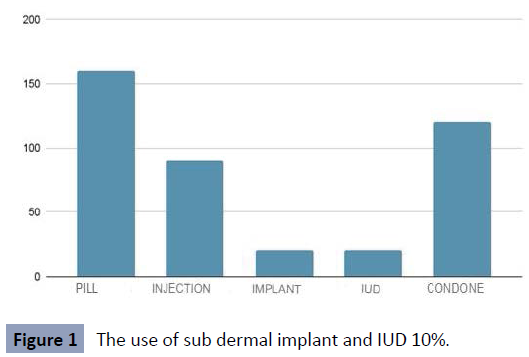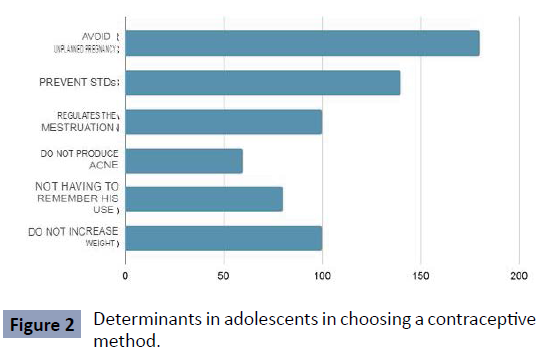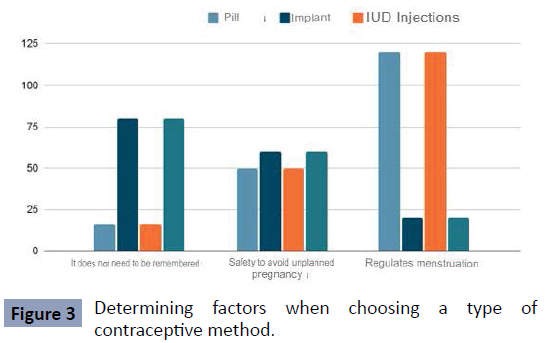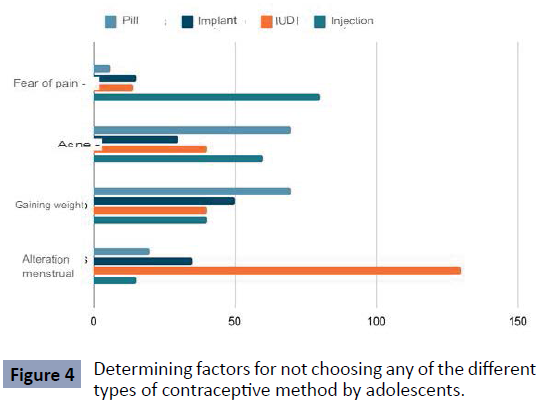Review Article - (2022) Volume 0, Issue 0
Determining Factors For The Choice Of A Contraceptive Method In An Adolescent Population In Colombia
Jhon Fredy Bello Cordero1*,
Cesar Camilo Leon Triana2,
Juan Pablo Gualdron Moncada3,
Arleth Sandry Hernandez Alvarez4,
Maria Cristina Suarez Gomez5,
Adam Andrew Ramos Howell6,
Carol Juliana Parra Navarro7 and
Andrea Carolina Montana Alarcon8
1Urgenciologist, Fundacion Universitaria de Ciencias de la Salud Bogota 9610, Colombia
2General Physician, Universidad Libre de Barranquilla, Colombia
3Pediatrics Resident, Corporacion Universitaria Remington, Colombia
4Dentist, Family Health Specialist, Universidad de Cartagena, Colombia
5Internal physician, Universidad Autonoma de Bucaramanga, Colombia
6General Physician, Universidad Tecnología Centroamericana (UNITEC), Colombia
7General Physician, Universidad Autónoma de Bucaramanga, Colombia
8General Physician, Universidad de la Sabana, Colombia
*Correspondence:
Jhon Fredy Bello Cordero, Urgenciologist, Fundacion Universitaria de Ciencias de la Salud Bogota 9610,
Colombia,
Email:
Received: 21-May-2022, Manuscript No. Iphsj-22-12789;
Editor assigned: 23-May-2022, Pre QC No. Iphsj-22-12789 (PQ);
Reviewed: 06-Jun-2022, QC No. QC No. Iphsj-22-12789;
Revised: 11-Jun-2022, Manuscript No. Iphsj-22-12789(R);
Published:
18-Jun-2022, DOI: 10.36648/1791-809X.16.S7.952
Abstract
Introduction: In Colombia, teenage pregnancy has become a public health problem in recent decades due to its tendency to increase in the general population of adolescents. In the country there have been few studies focused on identifying the level of knowledge, use and determinants for the choice of contraceptive methods focused on the prevention of teenage pregnancy.
Materials and Methods: An analytical cross-sectional study was carried out through a questionnaire that was applied to 200 adolescents from a population in a municipality in Colombia.
Results: It was found that oral contraceptives is the method that adolescents know the most and use the most, followed by injections. Avoiding pregnancies, protecting against STIs, and regulating menstrual periods are the most important reasons to use birth control. While the most important reasons for not choosing the pill had to remember its use every day. In the case of the implant, the fear and pain of placing and removing it was the most important reason.
Conclusions: Although effectiveness and long-term use can be very important advantages when choosing a contraceptive method, the fear of pain and insertion make long-lasting methods such as implantation and intrauterine devices less attractive to adolescents.
Keywords
Contraceptives; Pregnancy; Adolescentes; Pills
Introduction
According to statistics from the World Health Organization, there
are 2 billion women of childbearing age in the world, of whom 1.2
billion need family planning. Among these, 870 million use some
form of contraception and 300 million have unmet contraceptive
needs. [1] Ensuring that all women, especially adolescent girls,
have access to the contraceptive method of their choice has
strengthened a number of human rights, including the right to life
and liberty [2]. Contraceptive use can not only prevent pregnancyrelated
health risks for women, especially adolescent girls, but
also, when the interval between births is less than two years, the
infant mortality rate is 44% higher than when the interval is 2 to 3
years, and 64% higher than when the interval is 4 years or more,
so the use of adequate contraception would reduce these figures
and also provides many other potential non-health benefits,
including providing more educational opportunities for women,
as well as providing sustainable population growth and economic
development for the country [3].
In the last decade, both in Colombia and in most other Latin American countries, there has been an increase and a greater
precocity in the initiation of juvenile sexual activity and therefore
an increase in the number of teenage pregnancies, such pregnancies are often unwanted, unforeseen and constitute for
all a global public health problem [4].
Youth is a stage where great changes are going through and
therefore young people become more vulnerable and feel the
need to explore their sexuality, but on the other hand, the
ignorance of contraceptive methods means a great public health
problem, since it can lead to pregnancies or contagion of sexually
transmitted diseases [5, 6].
The combination of sex education and the large number of
contraceptives currently available play an important role in the
prevention of unwanted pregnancy in adolescents, however
different studies show that only about 20%-30% of adolescents
report having received some type of sex education or having
used some type of contraceptive during their sexual life [6-8]
The objective of this study was to identify those determining
factors when selecting a contraceptive method by adolescents
and their reasons for choosing or rejecting each of the available
methods and their knowledge.
Materials and Methods
This is an analytical cross-sectional study, carried out in a
population of adolescents in a municipality in Colombia, with the
availability of a wide variety of contraceptive methods, including
oral contraceptives, injectable, subcutaneous implants, copper
type T intrauterine device and condoms.
The information was collected through a questionnaire specially
designed for this purpose. Participants were asked to mark on a
scale of 1 to 5 (with 1, the least important and 5 being the most
important), the reasons for choosing a contraceptive method.
They were asked to say the most important reasons why they
would choose each of the methods indicated and the reasons
why they would not choose it. They were informed of the study
and asked for informed consent ensuring confidentiality and
anonymity of the data. Other variables studied were: Schooling,
age, marital status, activity, whether they had initiated sexual
activity or not and the use of contraceptives.
Results
Sociodemographic data
In the present research carried out with adolescents from
a municipality in Colombia, the following characterization
of the sample was found: 100% of the surveyed population
corresponded to the female sex, with ages between 17 and 20
years, with a predominance of 20 years (40%), followed by 17
years (30%), 18 years (20%) and 19 years (10%); thus considered
a sample of late adolescents and young adults [9].
The social stratum found ranges between level 1 and 4, most
between 1 and 2 with 45% and 20% respectively; With respect
to the health affiliation system, it was found that 60% are from
the contributory regime, and either because they work or are
beneficiaries or the rest are subsidized [10-14] (Table 1).
| Variable |
Categorias |
N |
% |
| Age |
17 |
60 |
30 |
|
18 |
40 |
20 |
|
19 |
20 |
10 |
|
20 |
80 |
40 |
| Social Class |
1 |
90 |
45 |
|
2 |
40 |
20 |
|
3 |
36 |
18 |
|
4 |
34 |
17 |
| Regime |
Subsidized |
80 |
40 |
|
Contributory |
120 |
60 |
Table 1. Sociodemographic data
The results correspond to 200 adolescents who agreed to
participate in the study and completed the questionnaire, the
average age was 15 years (95% CI: 15.0-16.5). 90% had already initiated sexual activity. 90% were students at the time of the
study and the average schooling achieved was 9.5 years (95% CI:
9.0-10.0). [15-18].
Contraceptive use
The contraceptive pill and the monthly injectable were the most
used contraceptive methods (80% and 45%), while condom use
reached 60%. The use of sub dermal implant and IUD 10% [19- 21] (Figure 1).
Figure 1: The use of sub dermal implant and IUD 10%.
Determinants in adolescents in choosing a
contraceptive method
The most important determining factors when choosing
a contraceptive method were: Effectiveness in avoiding
pregnancies 90%, protection against sexually transmitted
diseases 70%, regulating menstruation 50%, not producing acne
30%, not having to remember its use (Figure 2).
Figure 2: Determinants in adolescents in choosing a contraceptive
method.
Determining factors when choosing a type of
contraceptive method by adolescents
The adolescents when choosing a contraceptive method took
into account the fact that it did not need to be remembered
(40%) prioritizing in this case the use of the implant and IUD,
safety to avoid pregnancies (30%) highlighting the implant,
regulates menstruation (60%) highlighting contraceptive pills
[22,23] (Figure 3).
Figure 3: Determining factors when choosing a type of
contraceptive method.
Determining factors for not choosing any of
the different types of contraceptive method by
adolescents
Among the determining factors for not using a type of
contraceptive is the fear of pain in 80% highlighting the use
of injections and implant, development of acne in 60% for
contraceptive pills, gain weight in 60% prioritizing pills in the
same way and irregular bleeding in 65% highlighting the use of
IUDs [24] (Figure 4).
Figure 4: Determining factors for not choosing any of the different
types of contraceptive method by adolescents.
Discussion
In our country a large number of women from 15 to 20 years of
age are sexually active regardless of their marital status. There are
many barriers to the use of family planning services, in addition
to the use of contraceptives that include fear, shame, cost and
lack of knowledge. A study conducted in Argentina found that
adolescent girls have enough information about sexual health;
however, it was evident that they lacked guidance. In another
study conducted in Mexico, it was found that adolescents
mostly use ineffective contraceptive methods, because they are
only governed by the desire to avoid an unwanted pregnancy, but do not have extensive knowledge of the use of adequate
contraceptive methods [25].
In this study it was observed that the contraceptive methods
best known by adolescents are pills, injections, condom, IUD and
implant, data that agree with the findings made in the national
demographic survey in health in 2010, The contraceptive pill
and the monthly injectable were the contraceptive methods
most used by adolescents evaluated in our study, In the same
way, certain determining factors were found when choosing
a contraceptive method, among which the effectiveness in
avoiding pregnancies and protection against sexually transmitted
diseases stood out [26].
Despite the fact that a significant percentage of the population
studied had extensive knowledge about the different
contraceptive alternatives available, a low percentage used
them, among them the sub dermal implant, it is important to
note that the fear of insertion pain, the possibility that they could
gain weight or acne establishes limitations in the population.
Bleeding is another side effect that limits the use of these,
especially in methods such as injection, implantation and IUD,
which significantly contributed to its discontinuation and for
which there are currently various management schemes but are
not perceived as effective by adolescents.
Conclusion
The safety, duration and reliability provided by long-term
contraceptives makes them a great alternative as a method to
avoid teenage pregnancies, but the fear of pain and insertion
make these methods such as implantation and intrauterine
devices less used by adolescents. It is necessary a professional
accompaniment by professionals very well trained considering
the fears and contraceptive needs of each adolescent so that
they can choose the best contraceptive method according to
their needs.
REFERENCES
- Gonzalez E A, Breme P, Gonzalez D A, Molina T G, Leal I F (2017) Determinants en la election de anticonceptivos en adolescents consultants en un centro de atencion de salud sexual reproductive. Revista Chilean de obstetrician y ginecología 82:692-705.
Indexed at, Google Scholar, Crossref
- Ferreira H L O C, Barbosa D F, Aragao V M, Oliveira T M F D, Castro R C M B et al. (2019) Determinants Sociales de la Salud y su influence en la election del method anticonceptivo. Revista Brasileira de Enfermagem 72:1044-1051.
Google Scholar
- Castro R, Paz J (2021) Methods anticonceptivos elegidos por mujeres después de aborto en un hospital público de Honduras. Revista Médica Hondurena 89:96-102.
Indexed at, Google Scholar, Crossref
- Visconti-Lopez F J, Rojas Cueva A C (2021) Nivel de conocimiento y uso de metodos anticonceptivos en universitarios de Lima, Peru. CIMEL 26:23-33.
Google Scholar, Crossref
- Acevedo-Osorio GO, Ramirez Garcia N, Cardona Osorio J D, Oliveros-Ruiz C A (2019) Conocimiento y uso de method anticonceptivo de emergencies en estudiantes universitarios, Pereira, Colombia. Universidad y Salud 21:159-165.
Indexed at, Google Scholar, Crossref
- Duranteau L (2018) Anticoncepcion en las adolescentes. EMC-Ginecología-Obstetricia, 54:1-13.
Indexed at, Google Scholar, Crossref
- Peralta Y A, Quintero M S, Gutierrez O V (2020) Factores socioeconomics y el uso de métodos anticonceptivos en mujeres en edad fertil en Nicaragua. Apuntes de economía y sociedad 1:67-78.
Indexed at, Google Scholar, Crossref
- Gomez-Inclan S, Duran-Arenas L (2017) El acceso a métodos anticonceptivos en adolescentes de la Ciudad de Mexico. Salud publica de Mexico 59:236-247.
Indexed at, Google Scholar
- Sanchez-Retana C, Leiva Granados R (2016) Factores incidentes en el uso de métodos anticonceptivos en la oblation adolescent y adulta joven en Costa Rica. Oblation y Salud en Mesoamerica 14:83-107.
Google Scholar
- Atehortua Puerta W, Acosta S, Lopez A, Suarez J, Melo A (2011) Conocimiento métodos anticonceptivos en estudiantes de pregrado. Ciencia y Cuidado 8:47-54.
Indexed at, Google Scholar, Crossref
- Ayay Alvarez YR, Infante Cueva L (2018) Navel de conocimiento y practices sobre methods anticonceptivos en estudiantes de la Universidad Privada Antonio Guillermo Urrelo, Cajamarca. Perú 2018. Universidad Privada Antonio Guillermo Urrelo. La Universidad de Cajamarca.
Indexed at, Google Scholar
- Bravo Salinas S E, Guerra Ortega D L, Uguna Rosas V A, Castillo Zhizhpon A A (2020) Conocimiento y USO de methods anticonceptivos en estudiantes universitarios de medicina y enfermería. Recimundo 4:236-248.
Indexed at, Google Scholar, Crossref
- Covarrubias Lopez ES, Ramirez Villegas R, Verde Flota E E de J, Rivas Espinosa J G, Rivero Rodríguez L F (2015) Utilization de Methods Anticonceptivos en estudiantes de Enfermería. Investigation En Enfermería Imagen y Desarrollo 18:31.
Google Scholar, Crossref
- Del Pino D (2016) Nivel de conocimiento y USO de methods anticonceptivos en Madres adolescentes del Centro de Salud Chorrillos I Gustavo Lanatta Luján febrero abril Cybertesis.
Indexed at, Google Scholar
- Gomez-Camargo D E, Ochoa Diaz M M, Canchila Barrios CA, Ramos Clason E C, Salguedo Madrid G I, (2014) Salud sexual y reproductive en estudiantes universitarios de una institution de education superior en Colombia. Revista de Salud Publican 16:660-672.
Google Scholar, Crossref
- Gonzalez E A, Breme P, Gonzalez A D, Molina G T, Leal F I (2017) Determinants en la eleccion de anticonceptivos en adolescentes consultantes en un centro de atencion de salud sexual y reproductiva. Revista Chilena de Obstetricia y Ginecología 82:692-705.
Google Scholar, Crossref
- Guevara Chavez L L, Reyna Rios S Y (2016) Nivel de conocimiento sobre methods anticonceptivos y prácticas sexuales en adolescentes escolares. Chimbote, 2016. Universidad Nacional Del Santa.
Indexed at, Google Scholar
- Hernandez Sampieri R, Mendoza Jimenez C P (2018) Methodologies de la Investigation. Celaya McGraw Hill.
Google Scholar
- Juarez F, Gayet C (2005) Salud sexual y reproductiva de los adolescentes en México: UN nuevo marco de analysis para la evaluation y diseno de políticas. Papeles de Poblacion 11:177-219.
Indexed at, Google Scholar
- Mejia C R, Oporto F M, Taya C L, Oscco S S, Bustamante F M (2020) Factors socioeducativos asociados al no uso de métodos anticonceptivos en Universitaria de cuatro países de Latinoamérica. Revista Chilena de Obstetricia y Ginecología 85:245-254.
Indexed at, Google Scholar, Crossref
- Olmas J M (2016) Universidad nacional de cordoba facultad de ciencias médicas secretaría de graduados maestria en salud sexual y reproductiva. Universidad nacional de Cordoba.
Indexed at, Google Scholar
- Organization Mundial de la Salud (OMS) (2020) Planificacion familiar.
Google Scholar
- Pizzi R, Fernandez M, Fuenmayor J, Rodríguez E (2016) Revista de Obstetricia y Ginecología de Venezuela, 76:11-22.
Indexed at, Google Scholar
- Sánchez-Meneses M C, Davila Mendoza R, Ponce-Rosas E R (2015) Conocimiento y uso de métodos anticonceptivos en adolescentes de un centro de salud. Atención Familiar 22:35-38.
Indexed at, Google Scholar, Crossref
- Secretaria de Salud. Norma Official Mexicana, Nom 005-SSA2-1993, De los servicios de Planificación Familiar (1986). Mexico.
Indexed at
- Secretaria de Salud Reglamento de la Ley General de Salud en Materia de Investigaciones para la Salud., Ley General de Salud (1987). Mexico.
Google Scholar
Citation: Cordero JFB, Triana CCL, Moncada
JPG, Álvarez ASH, Gomez MCS, et al. (2022)
Determining Factors For The Choice Of A
Contraceptive Method In An Adolescent
Population In Colombia. Health Sci J. Vol. 16
No. S7: 952









